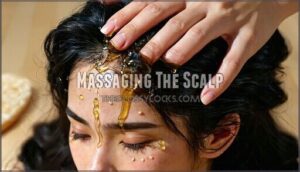This site is supported by our readers. We may earn a commission, at no cost to you, if you purchase through links.
 You’ll discover that indian hair growth secrets center around Ayurvedic practices that treat hair as a reflection of your overall health.
You’ll discover that indian hair growth secrets center around Ayurvedic practices that treat hair as a reflection of your overall health.
Indian women traditionally use warm oil massages with coconut, sesame, or amla oil to stimulate blood circulation and nourish follicles from root to tip.
They combine this with herbal treatments using fenugreek seeds, curry leaves, and hibiscus flowers that strengthen hair shafts and prevent breakage.
The secret isn’t just external care, though – it’s about balancing your dosha through proper nutrition, staying hydrated, and managing stress levels.
These time-tested methods work because they address the root causes of hair problems rather than masking symptoms.
The most powerful techniques involve specific ingredient combinations that maximize absorption.
Table Of Contents
- Key Takeaways
- Ayurvedic Hair Care Basics
- Natural Hair Growth Techniques
- Indian Hair Growth Secrets
- Hair Care Routines and Practices
- Nourishing Hair With Ayurveda
- What Are Indian Hair Growth Secrets?
- What is The Secret of Indian Women for Growing Hair?
- How Do Indian Women Take Care of Their Hair?
- How to Make Indian Hair Look Natural?
- What Are The Benefits of Using Ayurvedic Hair Care Products?
- What is The Secret of Indian Hair Growth?
- What Did Indians Use for Hair Growth?
- How Can I Thicken My Hair Naturally Indian?
- What is The Real Secret of Hair Growth?
- Frequently Asked Questions (FAQs)
- What is the secret of Indian hair growth?
- How can Indian hair grow faster naturally?
- How do Indians grow their hair so long?
- How can I regrow my Indian hair?
- Can pregnancy affect traditional hair care practices?
- How often should hair be washed weekly?
- What causes premature graying in young people?
- Do seasonal changes require different hair routines?
- Can damaged hair be completely restored naturally?
- Conclusion
Key Takeaways
- You’ll maximize hair growth by identifying your dosha type – Vata hair needs intensive moisture with sesame oil, Pitta hair requires cooling treatments like aloe vera, and Kapha hair benefits from light oils to prevent heaviness.
- You can stimulate follicles through traditional massage techniques – Warm oil scalp massages, done twice weekly, boost blood circulation, while the Balayam technique of rubbing fingernails together for 5-10 minutes daily activates nerve connections to your scalp.
- You’ll strengthen hair from within using Ayurvedic herbs and nutrition – Combine amla for vitamin C, bhringraj for root stimulation, and fenugreek for breakage prevention with a protein-rich diet that includes lentils and leafy greens.
- You must address the root causes holistically rather than just treating symptoms – Managing stress through yoga and meditation, staying hydrated with eight glasses of water daily, and maintaining consistent routines create the foundation for naturally thick, healthy hair growth.
Ayurvedic Hair Care Basics
Your hair type directly connects to your body’s natural constitution, which Ayurveda identifies through three primary doshas: Vata, Pitta, and Kapha.
Understanding whether you have dry, brittle Vata hair, sensitive Pitta hair, or oily Kapha hair allows you to create a personalized care routine that addresses your scalp’s specific needs.
Promoting stronger growth and healthier strands is the ultimate goal of this personalized approach, which is achieved by addressing the specific needs of your scalp based on your hair type.
Vata Hair Qualities
Most Vata hair types struggle with a unique combination of challenges that make them appear lifeless and fragile. If you’ve got Vata Hair Texture, you’re dealing with naturally wavy strands that feel like they’re constantly thirsty.
Vata hair drinks up moisture like a sponge but can never seem to hold onto it for long.
The elevated porosity means your hair drinks up moisture quickly but can’t hold onto it, leading to persistent Dry Scalp Issues and frustrating Porosity and Breakage. Your Hydration Needs are substantially higher than other doshas, requiring consistent attention through traditional Indian hair growth methods.
Ayurvedic hair care emphasizes regular Oiling Frequency – typically twice weekly with sesame or almond oils. This approach is crucial for managing Vata hair, which is prone to dryness and breakage due to its naturally wavy texture.
Some key characteristics of Vata hair include:
- Naturally wavy texture with high porosity
- Persistent dryness and flaky scalp conditions
- Hair that breaks easily when wet or styled
- Difficulty retaining moisture despite frequent treatments
- Requires intensive nourishing routines for ideal health
Pitta Hair Qualities
Most people with Pitta hair type struggle with scalp sensitivity and premature thinning, but understanding your dosha can transform your hair care routine.
Pitta doshas create naturally silky texture hair that’s prone to heat damage and reduced hair density.
Your customized hair care routines should emphasize cooling treatments like aloe vera masks and rose water rinses.
Following a Pitta diet rich in fresh fruits helps balance internal heat.
Achieving dosha balance requires consistent, gentle care that soothes rather than stimulates your sensitive scalp, using methods like aloe vera masks and rose water rinses to promote healthy hair.
Kapha Hair Qualities
Most people with Kapha hair type deal with an oily scalp and coarse texture from dense follicles.
Managing Kapha requires light oils like olive or sesame to prevent heaviness.
When Kapha imbalance occurs, you’ll notice excessive greasiness and sluggish growth.
Ayurvedic hair care focuses on dosha balance through astringent foods and gentle cleansing to maintain ideal hair texture.
Identifying Hair Type
Determining your hair type starts with a simple scalp analysis and texture check.
Notice excessive dryness or frizz? You likely have Vata hair.
Experiencing oily roots with thinning strands indicates Pitta hair characteristics.
Thick, coarse strands with greasy tendencies suggest Kapha hair.
Understanding hair porosity and recognizing dosha imbalance signs helps create the foundation for effective, personalized Ayurvedic care.
Customized Hair Care Routines
Now that you’ve identified your hair type, creating customized hair care routines becomes your roadmap to healthy growth.
Dosha analysis guides every decision, from product selection to seasonal adjustments that honor your body’s changing needs.
Your personalized routine requires three key elements:
- Oil selection – Choose sesame for Vata, coconut for Pitta, or olive for Kapha
- Weekly oiling schedules – Consistency amplifies these Indian hair growth secrets
- Lifestyle integration – Balance diet, stress management, and Ayurvedic hair care practices
Routine consistency transforms ancient natural hair remedies into modern results.
Natural Hair Growth Techniques
You’ve learned about balancing your dosha for ideal hair health, but specific techniques can accelerate your hair’s natural growth cycle.
These time-tested methods, ranging from simple water temperature adjustments to ancient nail-rubbing practices, work by stimulating blood circulation, strengthening hair follicles, and creating perfect conditions for your scalp to produce thicker, healthier strands, which involves stimulating blood circulation and strengthening hair follicles.
Cold Water Rinses
Finishing your hair wash with cold water is a game-changing Indian hair growth secret that your locks will thank you for.
The chilly temperature triggers cuticle sealing, which locks in moisture and creates that coveted shine enhancement.
This simple water temperature switch also delivers impressive frizz reduction while providing gentle scalp stimulation that encourages circulation.
These natural hair remedies from traditional Indian hair care routines prove that sometimes the most effective solutions are surprisingly straightforward.
Essential Oils for Hair Growth
Beyond cold water’s sealing power, essential oils reveal your hair’s true growth potential.
These concentrated botanicals transform scalp health through targeted nourishment and stimulation. You can find many essential oil products online.
Blending techniques with carrier oils maximize their effectiveness:
- Lavender benefits include stress reduction and improved follicle activity
- Rosemary stimulation boosts circulation, delivering nutrients to roots
- Tea tree purifies scalp, removing buildup that blocks growth
- Hair oil for growth combines multiple oils for holistic Ayurvedic hair care
Regular Trims for Healthy Hair
You might think regular trims slow growth, but they’re actually your hair’s best friend.
Hair cutting every 6-8 weeks prevents split end prevention from becoming a bigger problem.
This hair maintenance creates a growth rate illusion by stopping breakage that makes hair appear shorter.
Smart trim frequency guide keeps your hair texture impact smooth while maintaining hair shape and preventing future damage through proper hair breakage prevention.
Massaging The Scalp
While regular trims keep your hair healthy, scalp massage becomes your next game-changer.
Massage techniques using circular motions with hair oils facilitate blood circulation enhancement and hair growth stimulation. Oil selection matters—warm sesame or coconut oil works best.
Focus on pressure points around your hairline, with massage frequency of twice weekly delivering ideal benefits timing for scalp health.
- Boosts circulation for stronger roots
- Encourages nutrient absorption
- Relieves stress, enhancing hair health
- Conditions with natural oils
- Supports consistent growth naturally
Balayam Technique for Hair Growth
The Balayam technique involves rubbing your fingernails together for 5-10 minutes daily, creating scalp stimulation through nerve connections.
This fingernail massage method offers nail rubbing benefits by activating follicles naturally. Indian hair growth traditions embrace this simple practice for its effectiveness in promoting thickness and strength without expensive treatments.
| Technique Variations | Duration | Benefits |
|---|---|---|
| Basic nail rubbing | 5-7 minutes | Improved circulation |
| Vigorous rubbing | 8-10 minutes | Enhanced follicle activation |
| Gentle massage | 3-5 minutes | Stress reduction |
Indian Hair Growth Secrets
You’ve likely noticed how Indian women maintain remarkably thick, lustrous hair that seems to grow effortlessly, and this isn’t just genetics at work.
These time-tested secrets combine powerful Ayurvedic herbs, nourishing homemade treatments, and holistic lifestyle practices that address hair growth from multiple angles, creating a thorough approach that’s been refined over thousands of years, focusing on holistic lifestyle practices.
Using Ayurvedic Herbs for Hair Growth
When harnessing nature’s pharmacy for hair growth, amla benefits shine through its vitamin C content, which strengthens follicles and prevents premature greying.
Bhringraj uses include stimulating hair roots with iron and magnesium, while neem properties combat dandruff and scalp infections effectively.
Hibiscus effects promote growth by conditioning your scalp naturally.
These herbal combinations work synergistically in Ayurvedic hair care systems.
Create herbal hair treatments using amla for hair growth mixed with shikakai for hair cleansing, or blend fenugreek for hair masks.
These time-tested herbs transform weak strands into thick, lustrous locks.
Homemade Hair Masks for Nourishment
Homemade hair masks transform your kitchen into a hair care sanctuary, delivering deep nourishment through time-tested ingredients.
These DIY mask recipes harness nature’s power to restore vitality and strength to damaged strands.
- Amla for hair growth masks combine vitamin C-rich powder with coconut oil for follicle stimulation
- Fenugreek for hair treatments blend soaked seeds with yogurt to reduce breakage and add shine
- Ingredient benefits include protein from eggs, moisture from honey, and antioxidants from green tea
Mask application tips suggest sectioning hair and applying from roots to tips for even coverage.
Masking frequency should be weekly for ideal hair nourishment without overwhelming your scalp. Many users find benefits using amla for hair vitality.
Role of Diet in Hair Growth
Nourishing masks set the foundation, but your hair growth diet determines long-term success.
Ayurvedic diet principles emphasize dosha-specific diets that fuel follicles from within. Protein intake and hydration importance can’t be overlooked when addressing vitamin deficiencies.
Consider these Indian diet for hair growth essentials:
- Protein-rich lentils and almonds for keratin production
- Iron-packed spinach and pomegranates preventing deficiency
- Omega-3 walnuts reducing scalp inflammation
- Herbal supplements like triphala balancing doshas
- Vitamins from curry leaves strengthening roots naturally
Importance of Hydration for Hair Health
Your scalp is like a garden that needs consistent watering to flourish.
Scalp hydration through proper water intake directly impacts hair elasticity, helping strands bend without snapping.
Drinking eight glasses daily nourishes follicles from within, supporting Indian hair growth traditions.
This simple habit can reduce breakage and prevent dryness, creating the foundation for stronger locks.
When you prioritize hydration, you’re revealing one of the most fundamental hair growth secrets for superior hair health.
Managing Stress for Healthy Hair
Chronic stress releases cortisol and other stress hormones that disrupt your hair’s growth cycle, causing excessive shedding.
Stress reduction through yoga and meditation benefits your mind-body connection, reducing scalp tension while promoting emotional well-being.
These Ayurvedic principles of stress management create perfect conditions for hair fall control, helping you cultivate both inner peace and naturally thicker, healthier hair growth.
Hair Care Routines and Practices
You can transform your hair’s health by adopting time-tested Ayurvedic routines that address your scalp’s specific needs through targeted oiling, massage, and protective styling techniques.
These traditional practices, which include hot oil treatments and natural shampoos formulated to your dosha, create the foundation for stronger, thicker hair growth when performed consistently.
They are key to achieving stronger hair through consistent practice.
Hot Oil Treatments for Hair
Hot oil treatments represent the cornerstone of Indian hair growth secrets, delivering profound scalp benefits through ancient wisdom.
Choose oil types like coconut, sesame, or Ayurvedic hair care blends infused with amla.
Warm your selected hair oils gently, then apply using circular scalp massage motions.
These application methods boost circulation and penetrate follicles deeply.
Practice this ritual twice weekly for ideal treatment frequency.
Simple DIY recipes combining curry leaves with base oils create powerful nourishing treatments that transform hair health naturally.
Protective Hairstyles for Hair Growth
Smart protective hairstyles act like armor for your strands, creating the perfect environment for hair growth while practicing Indian hair care wisdom.
These low manipulation styles shield your hair from daily damage, promoting breakage prevention and moisture retention. Think of them as your hair’s best friend, offering style longevity while supporting scalp health.
- Braids keep ends tucked away from environmental damage
- Buns reduce friction against clothing and pillows
- Twists maintain natural curl patterns without stress
- Silk scarves protect edges during sleep
- Loose styles prevent tension-related breakage
Scalp Massages for Hair Stimulation
Through scalp massage, you release your hair’s natural growth potential.
Strategic massage techniques using circular motions boost blood circulation to hair follicles stimulation.
Oil selection matters—coconut or almond oils enhance results.
Frequency matters too; twice weekly sessions optimize scalp health.
Focus on pressure points around temples and crown for maximum hair stimulation.
| Massage Aspect | Ayurvedic Benefit |
|---|---|
| Scalp care circulation | Awakens dormant follicles |
| Massage tools pressure | Reduces daily stress |
| Oil absorption | Nourishes deeply |
Natural Shampoos for Hair Care
Most commercial shampoos strip your hair’s natural oils, but Ayurvedic cleansers work differently.
These herbal shampoo ingredients nourish while they cleanse, making them perfect shampoo alternatives for sensitive scalps.
- Shikakai powder: Nature’s detangler that strengthens roots
- Reetha for hair: Soapnut benefits include gentle cleansing action
- DIY shampoo recipes: Mix herbs with water for chemical-free washing
- Ayurvedic hair care: Traditional formulas prevent dryness and breakage
- Indian hair care: Time-tested methods for healthier strands
Ayurvedic Hair Oils for Strength
After exploring natural shampoos, Ayurvedic hair oils become your secret weapon for strengthening weak strands.
These herbal-infused treatments target specific dosha imbalances while delivering concentrated nutrients directly to your scalp.
Oil application methods vary, but warming enhances absorption for maximum scalp health impact.
Many consumers purchase these herbal remedies for hair care.
| Oil Type | Key Benefits |
|---|---|
| Coconut Oil | Nourishes scalp, reduces hair fall |
| Almond Oil | Strengthens roots, adds volume |
| Bhringraj Oil | Promotes growth, reduces breakage |
| Moringa Oil | Moisturizes strands, soothes scalp |
Nourishing Hair With Ayurveda
You’ll discover that Ayurvedic hair nourishment isn’t just about applying oils, but rather understanding your unique dosha type to create personalized treatments that address your hair’s specific needs.
This ancient system combines targeted nutrition, herbal remedies, and customized oil blends to restore balance, strengthen hair follicles, and promote the thick, lustrous growth that Indian women have achieved for thousands of years, through ancient system.
What Are Indian Hair Growth Secrets?
Indian hair growth secrets blend genetic factors with time-tested traditional remedies passed down through generations.
These cultural practices have gained scientific validation, proving their effectiveness beyond folklore.
- Ayurvedic hair care principles balance doshas for maximum growth
- Hair growth remedies using natural herbs like amla and bhringraj
- Traditional hair care rituals including regular oil massages
- Indian hair care techniques adapted for modern lifestyles
- Modern adaptations of ancient wisdom for contemporary use
What is The Secret of Indian Women for Growing Hair?
Traditional rituals form the backbone of Indian hair growth secrets, combining genetic factors with centuries-old wisdom.
You’ll discover that dietary influence plays a vital role, as Indian women consume nutrient-rich foods like amla and curry leaves.
Their holistic approach integrates Ayurvedic hair care principles with herbal remedies, creating long hair tips that address root causes rather than surface symptoms.
How Do Indian Women Take Care of Their Hair?
Devotion to hair care runs deep in Indian culture, where traditional practices blend seamlessly with daily routines.
You’ll find Indian women following generational knowledge passed down through families, incorporating Ayurvedic hair care rituals like weekly oil massages, herbal treatments, and community rituals.
These cultural influences emphasize natural remedies for hair growth, creating time-honored Indian hair care traditions that prioritize nourishment over quick fixes.
How to Make Indian Hair Look Natural?
Achieving authentic texture enhancement starts with embracing your hair’s natural pattern rather than fighting it.
Indian beauty secrets focus on natural styling techniques that work with your unique structure.
Use gentle scrunching methods for volume control, apply lightweight oils for damage prevention, and let air-drying reveal your hair’s inherent beauty while maintaining ideal hair health.
What Are The Benefits of Using Ayurvedic Hair Care Products?
Several compelling advantages make Ayurvedic hair care products worth your investment.
These natural formulations work harmoniously with your body’s systems, targeting root causes rather than symptoms.
Benefits include:
- Dosha balance – Products customize treatments for your unique constitution
- Natural ingredients – Chemical-free formulas minimize scalp irritation and damage
- Holistic approach – Addresses nutrition, stress, and overall health simultaneously
- Scalp health – Herbs like neem and amla purify while nourishing follicles
- Long-term benefits – Sustainable results without harsh side effects
What is The Secret of Indian Hair Growth?
Indian hair growth secrets stem from three core principles that work like a well-oiled machine.
You’ll discover that genetic factors, combined with traditional remedies and cultural practices, create the foundation for thick, lustrous hair.
This holistic approach addresses environmental influences while nurturing your scalp through time-tested Ayurvedic hair care methods.
| Secret Component | How It Works |
|---|---|
| Genetic factors | Natural predisposition to strong hair follicles |
| Traditional remedies | Herbal oils and natural treatments nourish roots |
| Cultural practices | Regular oiling rituals passed through generations |
| Environmental influences | Clean air and natural lifestyle support growth |
| Holistic approach | Mind-body balance promotes ideal hair health |
What Did Indians Use for Hair Growth?
Ancient ingredients formed the backbone of traditional Indian hair growth remedies.
You’d find coconut oil, almond oil, and hibiscus extracts in every household, applied through time-tested oiling techniques.
Herbal treatments included neem, brahmi, and amla, while dietary practices emphasized protein-rich lentils and iron-packed leafy greens.
These Ayurvedic hair care rituals created the foundation for naturally thick, lustrous hair.
How Can I Thicken My Hair Naturally Indian?
You can naturally thicken your hair using traditional techniques rooted in Ayurvedic hair care.
Start with dosha-specific oiling for volume – sesame oil for vata types, coconut for pitta, and olive for kapha.
Combine this with ayurvedic herbal remedies like amla and bhringraj.
Focus on a diet for thickness including protein-rich lentils, iron-packed leafy greens, and biotin sources. These thick hair solutions deliver proven results.
What is The Real Secret of Hair Growth?
The real secret of hair growth lies in understanding that your hair reflects your body’s overall health.
Your hair is your body’s mirror – when you nurture your whole self, your strands naturally flourish with strength and vitality.
Ayurvedic principles reveal that true hair growth secrets aren’t found in quick fixes, but in addressing systemic imbalances through holistic hair health approaches that honor your unique constitution and emotional wellbeing.
- Balance your doshas through personalized approach strategies that target your specific Vata, Pitta, or Kapha constitution
- Nourish from within by addressing nutritional deficiencies and digestive health that directly impact follicle strength
- Manage stress effectively since emotional wellbeing directly influences hormonal balance and hair growth cycles
Frequently Asked Questions (FAQs)
What is the secret of Indian hair growth?
You’ll achieve lustrous locks through time-tested rituals: regular oil massages with coconut or almond oil.
Dosha-based nutrition, herbal treatments like amla and neem, are also essential.
Plus scalp stimulation techniques that boost circulation and follicle health naturally.
How can Indian hair grow faster naturally?
You’ll accelerate hair growth by massaging warm coconut or almond oil into your scalp twice weekly.
Eating protein-rich foods like lentils, staying hydrated, and using amla-based treatments to strengthen roots naturally.
How do Indians grow their hair so long?
The theory holds true: Indians achieve impressive hair length through consistent oiling, scalp massages, and herbal treatments.
You’ll need regular oil applications, protective braiding, gentle cleansing with natural ingredients, and patience for gradual growth.
How can I regrow my Indian hair?
Start with weekly oil massages using coconut or almond oil, eat protein-rich foods like lentils and nuts.
Practice scalp massages, use herbal treatments like amla, and maintain consistent routines.
For ideal regrowth results.
Can pregnancy affect traditional hair care practices?
Pregnancy hormones can enhance hair thickness, but you’ll need to modify traditional practices.
Avoid strong herbal treatments like neem or fenugreek.
Stick to gentle oils like coconut or almond for safe scalp massages.
How often should hair be washed weekly?
Washing wisdom suggests you’ll want to cleanse your hair twice weekly for ideal health.
Over-washing strips natural oils, while under-washing creates buildup.
Your scalp’s oil production, lifestyle, and hair type determine your perfect frequency.
What causes premature graying in young people?
Genetics plays the biggest role, but you’re also dealing with stress, nutritional deficiencies, smoking, harsh chemicals, and autoimmune conditions that accelerate melanin loss in your hair follicles.
Do seasonal changes require different hair routines?
Like a chameleon adapts to its environment, your hair needs seasonal adjustments too.
Summer requires lighter oils and UV protection, while winter demands richer moisturizing treatments to combat dryness and static buildup.
Can damaged hair be completely restored naturally?
You can restore damaged hair naturally, but it takes time and patience.
Ayurvedic oils, herbal masks, and proper nutrition help repair existing strands while encouraging healthier new growth from your roots.
Conclusion
Adopting these indian hair growth secrets won’t turn you into Rapunzel overnight, but they’ll transform your hair care routine with proven results.
You’ve learned that Ayurvedic practices work by addressing root causes, not just symptoms. Start with warm oil massages, incorporate herbal treatments, and balance your dosha through proper nutrition.
Remember, consistency matters more than perfection. Your hair reflects your overall health, so treat it holistically.
These ancient indian hair growth secrets offer sustainable, natural solutions for stronger, thicker hair.
- https://www.mdpi.com/1422-0067/21/15/5342
- https://revivetrainings.com/wp-content/uploads/2019/07/16_11sSadick_KOGAN_1-1.pdf
- https://onlinelibrary.wiley.com/doi/abs/10.1111/dth.13168
- https://books.google.co.ke/books?id=TDZjDwAAQBAJ&pg=PT47&dq=balayam+technique&hl=en&sa=X&ved=2ahUKEwjz18eRh876AhXOQ_EDHWmkA-AQuwV6BAgLEAc















